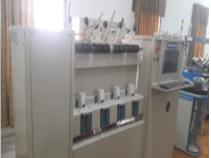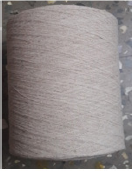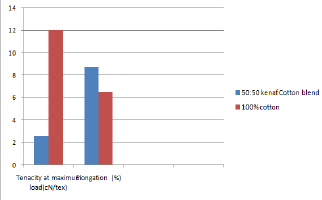- Submissions

Full Text
Trends in Textile Engineering & Fashion Technology
Development of Sustainable Textiles from Kenaf-Cotton Blended Yarn
Ramakrishna G*, Srinivasan J, Niveda and Gowtham S
Department of Fashion Technology, Kumaraguru College of Technology, India
*Corresponding author: Ramakrishna G, Department of Fashion Technology, Kumaraguru College of Technology, India
Submission: November 16, 2017; Published: February 16, 2018

ISSN: 2578-0271 Volume1 Issue3
Abstract
In the recent years, developing new yarn is the fundamental phenomenon for technical textiles. Different yarns are required now days for both technical as well as for aesthetic properties. Kenaf has good antimicrobial, fire resistance and absorbency that can be utilized in various textiles needed for society. The Kenaf cotton blended yarn of 50%-50% was produced through rotor spinning and was spun into 10Ne count. The quality was evaluated for yarn strength, yarn elongation, evenness and hairiness. The quality parameters of kenaf-cotton blended yarn were compared to 100% cotton yarn. The results reveal that the kenaf-cotton blended yarn were in comparable quality with 100% cotton and can be made into fabrics of different weave structures and can be utilized for various potential applications like home textiles and medical textiles focusing towards a sustainable environment.
Keywords: Kenaf; Cotton; Yarn; Quality; Sustainability
Introduction
Substantial amount of textiles is now used in homes to make life more comfortable. Textiles are also widely used in many industrial and technical textiles. Fabrics in earlier days were derived from fibers of animals and natural plant sources. In addition, social, psychological, physiological, physical economic parameters play a vital role in the selection of textile products, wearing and purchase decision.
Kenaf is a cellulosic fiber also known as Hibiscus Cannabinus L, which is grown in 12 states in India [1]. It grows in all soils at all climatic conditions with minimal amount of water for its growth [2]. The fibers are around 1m to 1.5m in length. It has got good absorbency, fire resistance and antimicrobial properties that can be utilized in textiles for various applications [3]. It is not affected by humidity and has excellent sound insulation and thermal insulation properties [4]. Single yarn fabric posses only the properties of one fiber but blended yarn posses the properties of both the fibers and hence they have unique characteristics Salam et al. [5], currently various researches are taking place on yarns and fabrics made from kenaf fiber. Some of them include researches on carding of the bast fibers Tao et al. [6], retting conditions for separating the bast fibers Lee et al. [7], Lee et al. [8], Morrision et al. [9], Parikh et al. [10] Wang et al. [11], physical/chemical properties of kenaf fibers [8,9,12],blending kenaf fibers with cotton Ramaswamy et al. [13] , Ramaswamy et al. [14] and rayon Lee et al. [15]and researches on nonwovens with kenaf fiber Parikh et al. [16]. These researches not only focuses towards sustainable development but also adds value to the crop.
This research mainly focuses towards the development of kenaf cotton blended yarn and evaluation of the quality parameters of the yarn that can be fabricated and used in various fields of textiles.
Material and Methods
Selection of fibers
Figure 1: Kenaf fibers.

Figure 2: Cotton fibers.

Kenaf fibers and cotton fibers were purchased from Bharatiya natural fibers, Coimbatore (Figure 1 & 2).
Properties and cross sectional view of kenaf fiber
Table 1: Kenaf and cotton fiber properties.

Figure 3: Cross sectional view of kenaf fibers Moreau et al. [19].

Through visual inspection, Kenaf fibers are generally coarser than the cotton fibers Napisah et al. [17] & bio resin based natural fibre [18]. The properties of both the kenaf and cotton are discussed in Table 1 & Figure 3 [19].
Softening of kenaf fiber
The fiber bundles were taken and were soaked in a vessel containing water. The vessel containing the Kenaf fibers were allowed to boil for 3 hours. After 3 hours the fibers were taken out and were allowed to dry.
Blending of kenaf and cotton
The softened fibers were cut in the length of 1 inch. The cut fibers were blended with cotton of length 30mm in the ratio 50%- 50% blend ratio.
Carding
Figure 4: Miniature carding machine.

It is a mechanical process that cleans and mixes fibers to produce webs or sliver suitable for subsequent processing. The fibers are passed through various rollers of different surfaces. It breaks the clumps formed in the fibers and then parallelizes the fiber. The kenaf fiber and the cotton fiber in the 50%:50% ratio was blended and was carded in a miniature carding machine and kenaf cotton webs were formed at first stage. The kenaf cotton webs produced were again carded to form the carded sliver (Figure 4).
Open end spinning
Figure 5: Miniature open end spinning machine.

Figure 6: Kenaf cotton blended yarn.

The carded slivers were spun in an open end spinning with rotor speed being 3000Rpm, open roller speed being 1100 Rpm and twist being and twist direction being z direction. The yarns were produced in 10s count (Figure 5 & 6).
Determination of mechanical properties of kenaf cotton blended yarn
Figure 7: Mechanical properties of kenaf cotton blended yarn.

Yarn strength was tested in a Universal Single column Instron tensile testing machine Model-3345. The values of Extension at maximum load (mm), Tenacity at maximum load (cN/tex) were determined and were compared to 100% cotton yarns [20], (Figure 7).
Yarn evenness
Table 2: Evenness value of kenaf cotton blended yarn.

Yarn evenness test was taken as per ASTM D 1425/D 1425M:2014 to find the U%, Imperfections (For OE) at R.H. 65%+/- 2%, Temp.21 Degree C+/-1 Degree C, Nom. twist 0 T/m , v= 400m/ min, t= 0.25min and were compared to 100% cotton yarn [20] (Table 2).
Results and Discussion
Kenaf cotton yarns were produced and were compared to the yarns produced from 100% cotton yarn [19]. The yarns produced had nominal strength. Due to the nominal strength of the yarn, elongation of the yarn was good. The U% of the yarn was 23% which is suitable to be spun into fabrics of various weave structures. Generally, the rotor spun yarns have less hairs than the ring spun yarns Zhang et al. [21].
Conclusion
Thus kenaf cotton blended yarns were successfully produced. Blended yarns are usually coarser than the single yarns. Softening with enzymes can also be implemented to improve the quality of this kenaf cotton yarn for textile applications. The yarns produced were not superior to 100% cotton yarns yet these yarns have various other attributes like color, luster, texture, appearance etc... Kenaf has various other natural properties like absorbency, fire resistant, sound insulation, Thermal insulation that will create a great impact on industrial textiles. The fabrics produced from these yarns can be used for bags, mats, home textiles, outer wear etc. Making use of kenaf fibers for various potential applications may also expand the cultivation of kenaf fibers.
Acknowledgement
The authors are grateful to the management of Kumaraguru College of Technology, Coimbatore, TIFAC-CORE and Natural Fiber Research Centre (NFRC) of Kumaraguru College of Technology, Coimbatore, India.
Conflict of Interest
The authors declare no conflict of interest.
References
- http://assamagribusiness.nic.in/mesta.pdf
- https://www.daf.qld.gov.au/plants/field-crops-and-pastures/sugar/ complementary-crops/kenaf
- http://www.fibre2fashion.com/industry-article/685 6/ecology- economy-and-equity?page=2
- http://www.termoisolanti.com/en/products/green-building/more- details-on-green-building/kenaf-fibre.php?lang=EN
- Salam MA, Farouqui FI, Md Mondal IH (2007) A study on sulphonated jute-cotton blended yarn and fabrics and their characteristics. Bangladesh Journal of Scientific and Industrial Research 42(3): 281-286.
- Tao W, Calamari TA, Crook L (1998) Carding kenaf for nonwovens. Textile Research Journal 68(6): 402-406.
- Lee HJ, Ahn CS, Kim JH, Yoo HJ, Han YS, et al. (2004) Effect of enzyme retting on the fiber separation of kenaf bast: influence of chelator. Journal of the Korean Society of Clothing and Textiles 28(7): 873-881.
- Lee HJ, Han YS, Yoo HJ, Kim JH, Song KH, et al. (2003) Effect of chemical retting on the fiber separation of kenaf bast. Journal of the Korean Society Clothing Textiles 27(9/10): 1144-1152.
- Morrision WH, Akin DE, Ramaswamy G, Baldwin B (1996) Evaluating chemically retted kenaf using chemical, histochemical, and microspectrophotometric analyses. Textile Research Journal 66(10): 651-656.
- Parikh DV, Calamari TA, Sawhney APS, Blanchard EJ, Screen FJ, et al. (2002) Improved chemical retting of kenaf fibers. Textile Research Journal 72(7): 618-624.
- Wang J, Ramaswamy GN (2005) Physical and chemical properties of wet processed hemp and kenaf. AATCC Review 5(1): 22-26.
- Wang J, Ramaswamy GN (2003) One step processing and bleaching of mechanically separated kenaf fibers: effects on physical and chemical properties. Textile Research Journal 73(4): 339-344.
- Ramaswamy GN, Body CR, Bel-Burger P, Kimmel L (1995) Kenaf/Cotton Blends for Textiles. Family Consumer Sciences Research Journal 24(2): 180-190.
- Ramaswamy GN, Easter EP (1997) Durability and aesthetic properties of kenaf/cotton blend fabrics. Textile Research Journal 67(11): 803-808.
- Lee HJ, Ahn CS, Kim GH, Yoo HJ, Han YS, et al. (2004) Characteristics of kenaf/rayon fabrics. Journal of the Korean Socience Clothing Textiles 28(910): 1282-1291.
- Parikh DV, Calamari TA, Sawhney APS, Blanchard EJ, Screen FJ, et al. (2002) Thermoformable automotive composites containing kenaf and other cellulosic fibers. Textile Research Journal 72(8): 668-672.
- Napisah S, Aidah J, Hakim RN (2014) Tensile and compressive properties of hybrid carbon fiber/kenaf polymer composite. Advances in Environmental Biology 8(3): 1-7.
- https://www.slideshare.net/PadmanabhanKrishnan2/bio-resin-based- natural-fibre-composites-and-their-applications
- Moreau JP, Bel-Berger P, Tao W (1995) Mechanical processing of kenaf for nonwovens. Tappi Journal 78(2): 96-105.
- (2011) Basic structural features of spun yarn. Spinning.
- Zhang Ting (2003) Improvement of kenaf yarn for apparel applications, Beijing university of chemical technology, China.
© 2018 Ramakrishna G, et al. This is an open access article distributed under the terms of the Creative Commons Attribution License , which permits unrestricted use, distribution, and build upon your work non-commercially.
 a Creative Commons Attribution 4.0 International License. Based on a work at www.crimsonpublishers.com.
Best viewed in
a Creative Commons Attribution 4.0 International License. Based on a work at www.crimsonpublishers.com.
Best viewed in 







.jpg)






























 Editorial Board Registrations
Editorial Board Registrations Submit your Article
Submit your Article Refer a Friend
Refer a Friend Advertise With Us
Advertise With Us
.jpg)






.jpg)














.bmp)
.jpg)
.png)
.jpg)










.jpg)






.png)

.png)



.png)






